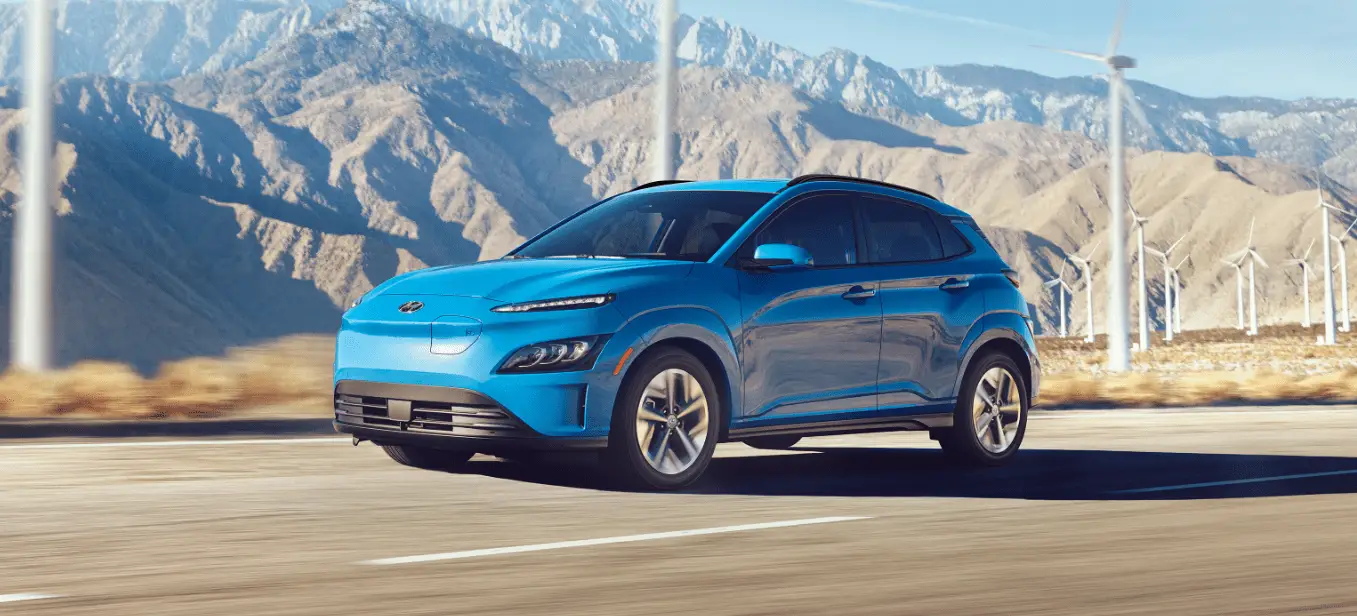Hyundai Kona-EV 2023 Safety Precautions, Seats and Seat Belts
In the ever-changing world of car comfort and safety, the 2023 Toyota Camry stands out as a leader of new ideas. It uses cutting-edge technology to make drive more enjoyable. The Camry’s advanced air conditioning system and defogger are at the heart of this innovation. They set new standards for both temperature control and visibility. By reading this detailed guide, we will learn how to use the 2023 Camry’s air conditioning and defroster in the most complex way possible. We will look at not only what they do, but also how they help keep the inside of the car comfortable for passengers and the windows clear so that you can drive safely and with confidence. This exploration gives both drivers and passengers the tools they need to make the trip more enjoyable and safe, whether it’s staying cool on a hot summer day, getting the best defogging during bad weather, or just setting the right mood inside the cabin.
2023 Hyundai Sonata Specs, Price, Features, Milage (Brochure)
IMPORTANT SAFETY PRECAUTIONS
You will find many safety precautions and recommendations throughout this section, and this manual. The safety precautions in this section are among the most important.
Always Wear Your Seat Belt
A seat belt is your best protection in all types of accidents. Airbags are designed to supplement seat belts, not replace them. So even though your vehicle is equipped with air bags, ALWAYS make sure you and your passengers wear your seat belts and wear them properly.
Restrain All Children
All children under age 13 should ride
in your vehicle properly restrained in the rear seat, not the front seat. Infants and small children should be restrained in an appropriate Child Restraint System. Larger children should use a booster seat with the lap/shoulder belt until they can use the seat belt properly without a booster seat.
Air Bag Hazards
While airbags can save lives, they can also cause serious or fatal injuries to occupants who sit too close to them, or who are not properly restrained. Infants, young children, and short adults are at the greatest risk of being injured by an inflating airbag. Follow all instructions and warnings in this manual.
Driver Distraction
Driver distraction presents a serious and potentially deadly danger, especially for inexperienced drivers. Safety should be the first concern when behind the wheel and drivers need to be aware of the wide array of potential distractions, such as drowsiness, reaching for objects, eating, personal grooming, other passengers, and using cellular phones.
Drivers can become distracted when they take their eyes and attention off the road or their hands off the wheel to focus on activities other than driving. To reduce your risk of distraction and an accident:
- ALWAYS set up your mobile devices (for example, MP3 players, phones, navigation units, etc.) when your vehicle is parked or safely stopped.
- ONLY use your mobile device when allowed by laws and conditions permit safe use. NEVER text or email while driving. Most states have laws prohibiting drivers from texting. Some states and cities also prohibit drivers from using handheld phones.
- NEVER let the use of a mobile device distract you from driving. You have a responsibility to your passengers and others on the road to always drive safely, with your hands on the wheel as well as your eyes and attention on the road.
Control Your Speed
Excessive speed is a major factor in crash injuries and deaths. Generally, the higher the speed, the greater the risk, but serious injuries can also occur at lower speeds. Never drive faster than is safe for current conditions, regardless of the maximum speed posted.
Keep Your Vehicle In Safe Condition
Having a tire blowout or a mechanical failure can be extremely hazardous. To reduce the possibility of such problems, check your tire pressures and condition frequently, and perform all regularly scheduled maintenance.
SEATS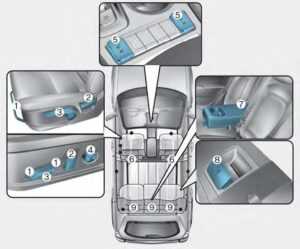 [A] : Front seat, [B] : Rear seat
[A] : Front seat, [B] : Rear seat
Front seat
- Forward and backward
- Seatback angle
- Seat cushion height*
- Lumbar support (Driver’s seat)*
- Seat warmer*/Air ventilation seat*
- Head Restraint
Rear seat - Armrest*
- Seatback folding
- Head Restraint
* : if equipped
Safety Precautions
Adjusting the seats so that you are sitting in a safe, comfortable position plays an important role in driver and passenger safety, together with seat belts and air bags, in an accident.
WARNING
Do not use a cushion that reduces friction between the seat and the passenger. The passenger’s hips may slide under the lap portion of the seat belt during an accident or a sudden stop.
Serious or fatal internal injuries could result because the seat belt cannot operate properly.
Airbags
You can take steps to reduce the risk of being injured by an inflating air bag. Sitting too close to an air bag greatly increases the risk of injury in the event the air bag inflates. Move your seat as far back as possible from front airbags, while still maintaining control of the vehicle.
WARNING
To reduce the risk of serious injury or death from an inflating airbag, take the following precautions:
- Adjust the driver’s seat as far to the rear as possible while maintaining the ability to control the vehicle.
- Adjust the front passenger seat as far to the rear as possible.
- Hold the steering wheel by the rim with your hands at the 9 o’clock and 3 o’clock positions to minimize the risk of injuries to your hands and arms.
- NEVER place anything or anyone between you and the air bag.
- Do not allow the front passenger to place feet or legs on the dashboard to minimize the risk of leg injuries.
Seat belts
Always fasten your seat belt before starting any trip. At all times, passengers should sit upright and be properly restrained. Infants and small children must be restrained in appropriate Child Restraint Systems. Children who have outgrown a booster seat and adults must be restrained using the seat belts.
WARNING
Take the following precautions when adjusting your seat belt:
- NEVER use one seat belt for more than one occupant.
- Always position the seatback upright with the lap portion of the seat belt snug and low across the hips.
- NEVER allow children or small infants to ride on a passenger’s lap.
- Do not route the seat belt across your neck, across sharp edges, or reroute the shoulder strap away from your body.
- Do not allow the seat belt to become caught or jammed.
Front Seats
The front seat can be adjusted by using the control lever (or knob) or switches located on the outside of the seat cushion. Before driving, adjust the seat to the proper position so that you can easily control the steering wheel, foot pedals and controls on the instrument panel.
WARNING
Take the following precautions when adjusting your seat:
- NEVER attempt to adjust the seat while the vehicle is moving. The seat could respond with unexpected movement and may cause loss of vehicle control resulting in an accident.
- Do not place anything under the front seats. Loose objects in the driver’s foot area could interfere with the operation of the foot pedals, causing an accident.
- Do not allow anything to interfere with the normal position and proper locking of the seatback.
- Do not place a cigarette lighter on the floor or seat. When you operate the seat, gas may exit out of the lighter causing a fire.
- Use extreme caution when picking up small objects trapped under the seats or between the seat and the center console. Your hands might be cut or injured by the sharp edges of the seat mechanism.
- If there are occupants in the rear seats, be careful while adjusting the front seat position.
- Make sure that the seat is locked in place after the adjustment. If not, the seat might move unexpectedly resulting in an accident.
CAUTION
To prevent injury:
- Do not adjust your seat while wearing your seat belt.
Moving the seat cushion forward may cause strong pressure on your abdomen. - Do not allow your hands or fingers to get caught in the seat mechanisms while the seat is moving.
Manual adjustment (if equipped)
Forward and rearward adjustment
To move the seat forward or rearward:
- Pull up the seat slide adjustment lever and hold it.
- Slide the seat to the position you desire.
- Release the lever and make sure the seat is locked in place. Move forward and rearward without using the lever.
If the seat moves, it is not locked properly.
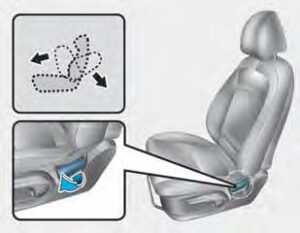 Seatback angle
Seatback angle
To recline the seatback:
- Lean forward slightly and lift up the seatback lever.
- Carefully lean back on the seat and adjust the seatback to the position you desire.
- Release the knob and make sure the seatback is locked in place.
Reclining seatback
Sitting in a reclined position when the vehicle is in motion can be dangerous. Even when buckled up, the protections of your restraint system (seat belts and/or air bags) are greatly reduced by reclining your seatback.
WARNING
NEVER ride with a reclined seatback when the vehicle is moving.
Riding with a reclined seatback increases your chance of serious or fatal injuries in the event of a collision or sudden stop.
Drivers and passengers should ALWAYS sit well back in their seats, properly belted, and with the seatbacks upright.
Seat belts must be snug against your hips and chest to work properly. When the seatback is reclined, the shoulder belt cannot do its job because it will not be snug against your chest. Instead, it will be in front of you. During an accident, you could be thrown into the seat belt, causing neck or other injuries.
The more the seatback is reclined, the greater chance the passenger’s hips will slide under the lap belt or the passenger’s neck will strike the shoulder belt.
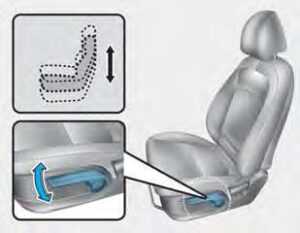 Seat cushion height
Seat cushion height
To change the height of the seat cushion:
- Push down the lever several times, to lower the seat cushion.
- Pull up the lever several times, to raise the seat cushion.
Power adjustment (if equipped)
The front seat can be adjusted by using the control switches located on the outside of the seat cushion. Before driving, adjust the seat to the proper position so that you can easily control the steering wheel, foot pedals and controls on the instrument panel.
WARNING
NEVER allow children in the vehicle unattended. The power seats are operable when the vehicle is turned off.
NOTICE
To prevent damage to the seats:
- Always stop adjusting the seats when the seat has been adjusted as far forward or rearward as possible.
- Do not adjust the seats longer than necessary when the vehicle is turned off. This may result in unnecessary battery drain.
- Do not operate two or more seats at the same time. This may result in an electrical malfunction.
 Forward and rearward adjustment
Forward and rearward adjustment
To move the seat forward or rearward:
- Push the control switch forward or rearward.
- Release the switch once the seat reaches the desired position.
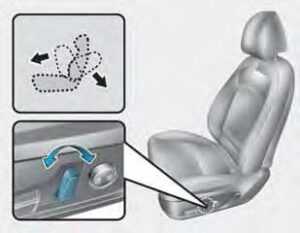 Seatback angle
Seatback angle
To recline the seatback:
- Push the control switch forward or rearward.
- Release the switch once the seatback reaches the desired position.
Reclining seatback
Sitting in a reclined position when the vehicle is in motion can be dangerous. Even when buckled up, the protection of your restraint system (seat belts and air bags) is greatly reduced by reclining your seatback.
WARNING
NEVER ride with a reclined seatback when the vehicle is moving.
Riding with a reclined seatback increases your chance of serious or fatal injuries in the event of a collision or sudden stop.
Driver and passengers should always sit well back in their seats with the seatbacks upright and should be belted properly.
Seat belts must be snug against your hips and chest to work properly. When the seatback is reclined, the shoulder belt cannot do its job because it will not be snug against your chest. Instead, it will be in front of you. During an accident, you could be thrown into the seat belt, causing neck or other injuries.
The more the seatback is reclined, the greater chance the passenger’s hips will slide under the lap belt or the passenger’s neck will strike the shoulder belt.
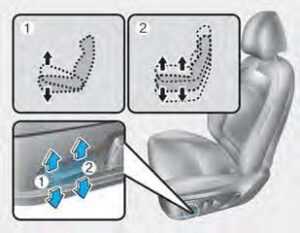 Seat cushion tilt (1, if equipped)
Seat cushion tilt (1, if equipped)
To change the angle of the front part of the cushion:
Push the front portion of the control switch up to raise or down to lower the front part of the seat cushion.
Release the switch once the seat reaches the desired position.
Seat cushion height (2, if equipped)
To change the height of the seat cushion:
Push the rear portion of the control switch up to raise or down to lower the height of the seat cushion.
Release the switch once the seat reaches the desired position.
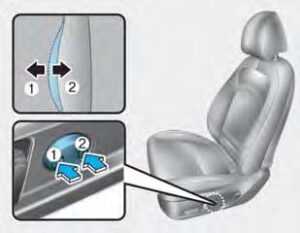 Lumbar support (for driver’s seat, if equipped)
Lumbar support (for driver’s seat, if equipped)
To adjust the lumbar support:
- Press the front portion of the switch (1) to increase support or the rear portion of the switch (2) to decrease support.
- Release the switch once it reaches the desired position.
Seatback pocket (if equipped)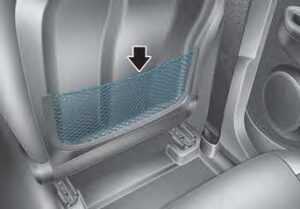 The seatback pocket is provided on the back of the seats.
The seatback pocket is provided on the back of the seats.
CAUTION
Do not put heavy or sharp objects in the seatback pockets. In an accident, they could come loose from the pocket and injure occupants.
Rear Seats
Folding the rear seat
The rear seatbacks can be folded to facilitate carrying long items or to increase the luggage capacity of the vehicle.
WARNING
- Never allow passengers to sit on top of the folded-down seatback while the vehicle is moving. This is not a proper seating position and no seat belts are available for use. This could result in serious injury or death in case of an accident or sudden stop.
- Objects carried on the folded-down seatback should not extend higher than the top of the front seatback. This could allow cargo to slide forward and cause injury or damage during sudden stops.
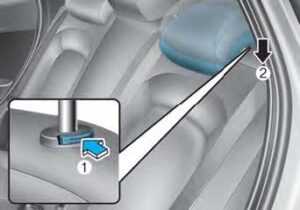
To fold down the rear seatback:
- Set the front seatback to the upright position and if necessary, slide the front seat forward.
- Lower the rear head restraints to the lowest position by pushing and holding the release button (1) and pushing down on the head restraint (2).
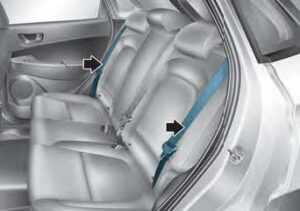
- Locate the seatbelt toward the outboard position before folding down the seatback. If not, the seatbelt system may be interfered by the seatback.
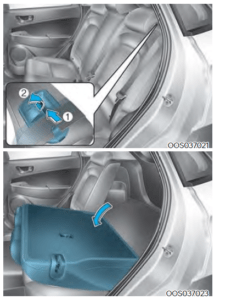
- Remove the belt from the guide (1) and pull up the seatback folding lever (2), then fold the seat toward the front of the vehicle.
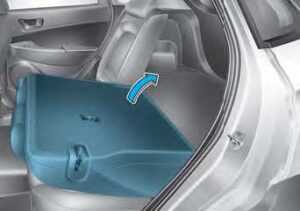
- To use the rear seat, lift and push the seat back rearward.
Push the seatback firmly until it clicks into place. Make sure the seatback is locked in place.
Return the belt in the guide.
WARNING
When returning the rear seatback from a folded to an upright position, hold the seatback and return it slowly. Ensure that the seatback is completely locked into its upright position by pushing on the top of the seatback. In an accident or sudden stop, the unlocked seatback could allow cargo to move forward with great force and enter the passenger compartment, which could result in serious injury or death.
WARNING
Do not place objects in the rear seats, since they cannot be properly secured and may hit vehicle occupants in a collision causing serious injury or death.
CAUTION
Damaging rear seat belt buckles
When you fold the rear seatback, insert the buckle in the pocket between the rear seatback and cushion. Doing so can prevent the buckle from being damaged by the rear seatback.
WARNING
Make sure the vehicle is off, the vehicle is shifted to P (Park), and the parking brake is securely applied whenever loading or unloading cargo. Failure to take these steps may allow the vehicle to move if the shift lever is inadvertently moved to another position.
CAUTION
- Be careful when loading cargo through the rear passenger seats to prevent damage to the vehicle interior.
- When cargo is loaded through the rear passenger seats, ensure the cargo is properly secured to prevent it from moving while driving.
- Unsecured cargo in the passenger compartment can cause damage to the vehicle or injury to it’s occupants.
WARNING
Cargo should always be secured to prevent it from being thrown about the vehicle in a collision and causing injury to the vehicle occupants. Do not place objects in the rear seats, since they cannot be properly secured and may hit the front seat occupants in a collision.
2023 Hyundai Sonata Specs, Price, Features, Milage (Brochure)
Armrest (if equipped)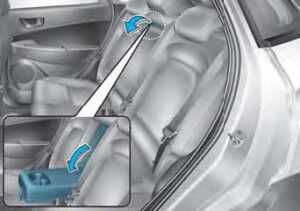 The armrest is located in the center of the rear seat. Pull the armrest down by using the strap from the seatback to use it.
The armrest is located in the center of the rear seat. Pull the armrest down by using the strap from the seatback to use it.
Head Restraint
The vehicle’s front and rear seats have adjustable head restraints. The head restraints provide comfort for passengers, but more importantly, they are designed to help protect passengers from whiplash and other neck and spinal injuries during an accident, especially in a rear-impact collision.
WARNING
To help reduce the risk of serious injury or death in an accident, take the following precautions when adjusting your head restraints:
- Always properly adjust the head restraints for all passengers BEFORE starting the vehicle.
- NEVER let anyone ride in a seat with the head restraint removed or reversed.
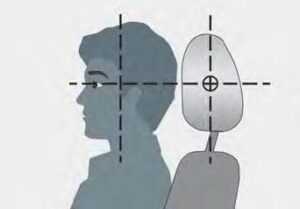 Adjust the head restraints so the middle of the head restraint is at the same height as the height of the top of the eyes.
Adjust the head restraints so the middle of the head restraint is at the same height as the height of the top of the eyes. - NEVER adjust the head restraint position of the driver’s seat when the vehicle is in motion.
- Adjust the head restraint as close to the passenger’s head as possible. Do not use a seat cushion that holds the body away from the seatback.
- Make sure the head restraint locks into position after adjusting it.
NOTICE
To prevent damage, NEVER hit or pull on the head restraints.
CAUTION
When there is no occupant in the rear seats, adjust the height of the head restraint to the lowest position. The rear seat head restraint can reduce the visibility of the rear area.
Front seat head restraints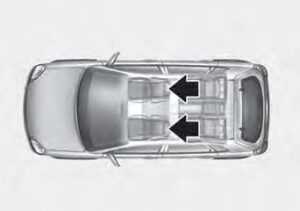
The driver’s and front passenger’s seats are equipped with adjustable head restraints for the passenger’s safety and comfort.
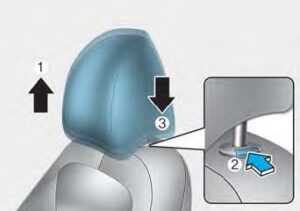
Adjusting the height up and down
To raise the head restraint:
- Pull it up to the desired position (1).
To lower the head restraint:
- Push and hold the release button (2) on the head restraint support.
- Lower the head restraint to the desired position (3).
 Forward and rearward adjustment (if equipped)
Forward and rearward adjustment (if equipped)
The head restraint may be adjusted forward to 3 different positions by pulling the head restraint forward to the desired detent. To adjust the head restraint to it’s furthest rearwards position, pull it fully forward to the farthest position and release it. 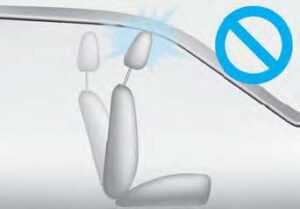 NOTICE
NOTICE
If you recline the seatback towards the front with the head restraint and seat cushion raised, the head restraint may come in contact with the sunvisor or other parts of the vehicle. 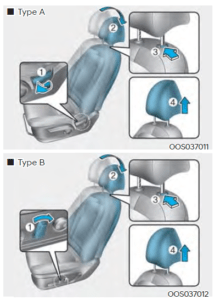 Removal/Reinstall
Removal/Reinstall
To remove the head restraint:
- Recline the seatback (2) with using the seatback angle lever or switch (1).
- Raise the head restraint as far as it can go.
- Press the head restraint release button (3) while pulling the head restraint up (4).
WARNING
NEVER allow anyone to travel in a seat with the head restraint removed.
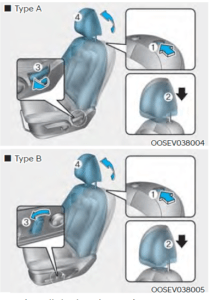 To reinstall the head restraint :
To reinstall the head restraint :
- Recline the seatback.
- Put the head restraint poles (2) into the holes while pressing the release button (1).
- Adjust the head restraint to the appropriate height.
- Recline the seatback (4) the seatback angle lever or switch (3).
WARNING
Always make sure the head restraint locks into position after reinstalling and adjusting it properly.
Rear seat head restraints The rear seats are equipped with head restraints in all the seating positions for the passenger’s safety and comfort.
The rear seats are equipped with head restraints in all the seating positions for the passenger’s safety and comfort.
CAUTION
- Adjust the head restraints so the middle of the head restraint is at the same height as the height of the top of the eyes.
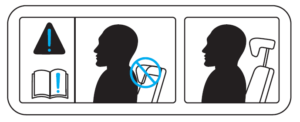
- When sitting on the rear seat, do not adjust the height of the head restraint to the lowest.
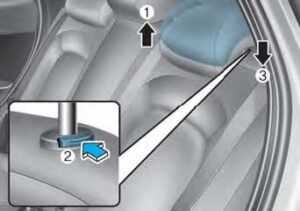
Adjusting the height up and down
To raise the head restraint:
- Pull it up to the desired position (1).
To lower the head restraint:
- Push and hold the release button (2) on the head restraint support.
- Lower the head restraint to the desired position (3).
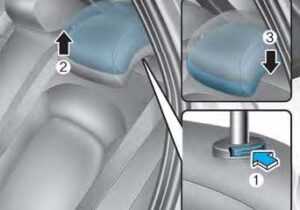 Removal/Reinstallation
Removal/Reinstallation
To remove the head restraint:
- Raise the head restraint as far as it can go.
- Press the head restraint release button (1) while pulling the head restraint up (2).
To reinstall the head restraint:
- Put the head restraint poles into the holes (3) while pressing the release button (1).
- Adjust the head restraint to the appropriate height.
WARNING
Make sure the head restraint locks in position after adjusting it to properly protect the occupants.
Seat Warmers and Air Ventilation Seats
Front seat warmers (if equipped)
Seat warmers are provided to warm the seats during cold weather.
WARNING
The seat warmers can cause a SERIOUS BURN, even at low temperatures and especially if used for long periods of time.
Passengers must be able to feel if the seat is becoming too warm so they can turn it off, if needed.
People who cannot detect temperature change or pain to the skin should use extreme caution, especially the following types of passengers:
- Infants, children, elderly or disabled persons, or hospital outpatients.
- People with sensitive skin or who burn easily.
- Fatigued individuals.
- Intoxicated individuals.
- People taking medication that can cause drowsiness or sleepiness.
WARNING
NEVER place anything on the seat that insulates against heat when the seat warmer is in operation, such as a blanket or seat cushion. This may cause the seat warmer to overheat, causing a burn or damage to the seat.
NOTICE
To prevent damage to the seat warmers and seats:
- Never use a solvent such as paint thinner, benzene, alcohol or gasoline to clean the seats.
- Do not place heavy or sharp objects on seats equipped with seat warmers.
- Do not change the seat cover. It may damage the seat warmer.
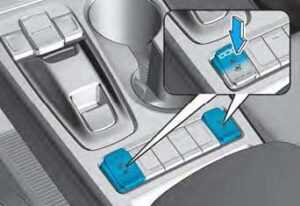 While the vehicle is running, push either of the switches to warm the driver’s seat or front passenger’s seat.
While the vehicle is running, push either of the switches to warm the driver’s seat or front passenger’s seat.
During mild weather or under conditions where the operation of the seat warmer is not needed, keep the switches in the OFF position.
- Each time you push the switch, the temperature setting of the seat is changed as follows :

- When pressing the switch for more than 1.5 seconds with the seat warmer operating, the seat warmer will turn OFF.
- The seat warmer defaults to the OFF position whenever the START/STOP button is placed to the ON position.
Information
With the seat warmer switch in the ON position, the heating system in the seat turns off or on automatically depending on the seat temperature.
Front air ventilation seat (if equipped)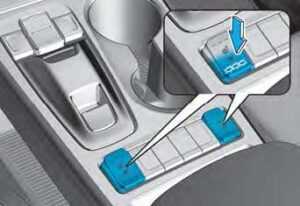
The air ventilation seats are provided to cool the front seats by blowing air through small vent holes on the surface of the seat cushions and seatbacks.
When the operation of the air ventilation seat is not needed, keep the switches in the OFF position.
While the vehicle is running, push the switch to cool the driver’s seat or the front passenger’s seat (if equipped).
- Each time you push the switch, the airflow changes as follows:

- When pressing the switch for more than 1.5 seconds with the air ventilation seat operating, the operation will turn Off.
- The air ventilation seats default to the OFF position whenever the START/STOP button is placed to the ON position.
NOTICE
To prevent damage to the air ventilation seat:
- Use the air ventilation seat ONLY when the climate control system is on. Using the air ventilation seat for prolonged periods of time with the climate control system off could cause the air ventilation seat to malfunction.
- Never use a solvent such as paint thinner, benzene, alcohol or gasoline to clean the seats.
- Avoid spilling liquids on the surface of the front seats and seatbacks; this may cause the air vent holes to become blocked and not work properly.
- Do not place materials such as plastic bags or newspapers under the seats. They may block the air intake causing the air vents to not work properly.
- Do not change the seat covers. It may damage the air ventilation seat.
- If the air vents do not operate, restart the vehicle. If there is no change, have your vehicle inspected by an authorized HYUNDAI dealer.
SEAT BELTS
This section describes how to use seat belts properly. It also describes some of the things not to do when using seat belts.
Seat Belt Safety Precautions
Always fasten your seat belt and make sure all passengers have fastened their seat belts before starting any trip. Airbags are designed to supplement the seat belt as an additional safety device, but they are not a substitute. Most states require all occupants of a vehicle to wear seat belts.
WARNING
Seat belts must be used by ALL passengers whenever the vehicle is moving. Take the following precautions when adjusting and wearing seat belts:
- Children under the age of 13 should be properly restrained in the rear seats.
- Never allow children to ride in the front passenger seat, unless the airbag is deactivated. If a child is seated in the front passenger seat, move the seat as far back as possible. And the child must always be restrained in the seat properly.
- NEVER allow an infant or child to be carried on an occupant’s lap.
- NEVER ride with the seatback reclined when the vehicle is moving.
- Do not allow children to share a seat or seat belt.
- Do not wear the shoulder belt under your arm or behind your back.
- Never wear a seat belt over fragile objects. If there is a sudden stop or impact, the seat belt can damage it.
- Do not use the seat belt if it is twisted. A twisted seat belt will not protect you properly in an accident.
- Do not use a seat belt if the webbing or hardware is damaged.
- Do not latch the seat belt into the buckles of other seats.
- NEVER unfasten the seat belt while driving. This may cause loss of vehicle control resulting in an accident.
- Make sure there is nothing in the buckle interfering with the seat belt latch mechanism because any materials in the buckle can cause the seat belt not to be fastened securely.
- No modifications or additions should be made by the user which will either prevent the seat belt adjusting devices from operating to remove slack, or prevent the seat belt assembly from being adjusted to remove slack.
WARNING
Damaged seat belts and seat belt assemblies will not operate properly.
Always replace:
- Frayed, contaminated, or damaged webbing.
- Damaged hardware.
- The entire seat belt assembly after it has been worn in an accident, even if damage to webbing or assembly is not apparent.
Seat Belt Warning Light
Seat belt warning
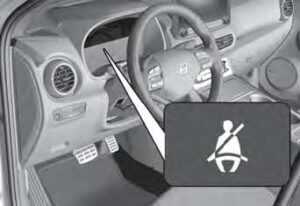
Driver’s seat belt warning
As a reminder to the driver, the seat belt warning light will illuminate for approximately 6 seconds each time
the START/STOP button is turned on regardless of belt fastening. If the driver’s seat belt is not fastened, the warning chime will sound for about 6 seconds.
If the seat belt is not fastened when
the START/STOP button is turned on or if it is disconnected after the START/STOP button is turned on, the seat belt warning light will illuminate until the belt is fastened.
If you start to drive without the seat belt fastened or you unfasten the seat belt when you drive under 12 mph (20 km/h), the corresponding warning light will continue to illuminate until you fasten the seat belt.
If you continue to drive without the seat belt fastened or you unfasten the seat belt when you drive over 12 mph (20 km/h), the seat belt warning chime will sound for approximately 100 seconds and the corresponding warning light will blink.

Front passenger’s seat belt warning
As a reminder to the front passenger, the front passenger’s seat belt warning light will illuminate for approximately 6 seconds each time the START/STOP button is turned on regardless of belt fastening. If the seat belt is not fastened when the START/STOP button is turned on or if it is disconnected after the START/STOP button is turned on, the seat belt warning light will illuminate until the belt is fastened.
If you start to drive without the seat belt fastened or you unfasten the seat belt when you drive under 12 mph (20 km/h), the corresponding warning light will continue to illuminate until you fasten the seat belt.
If you continue to drive without the seat belt fastened or you unfasten the seat belt when you drive over 12 mph (20 km/h), the seat belt warning chime will sound for approximately 100 seconds and the corresponding warning light will blink.
WARNING
Riding in an improper position adversely affects the front passenger’s seat belt warning system. The driver needs to instruct the passenger to be seated properly as instructed in this manual.
Information
- You can find the front passenger’s seat belt warning light on the centre fascia panel.
- Although the front passenger seat is not occupied, the seat belt warning light will blink or illuminate for 6 seconds.
- The front passenger’s seat belt warning may operate when luggage is placed on the front passenger seat.

Rear passenger’s seat belt warning (if equipped)
- As a reminder to the rear passenger, the rear passenger’s seat belt warning lights will illuminate for approximately 6 seconds each time the START/STOP button is turned on regardless of belt fastening.
- As a reminder to the rear passenger, the rear passenger’s seat belt warning lights will illuminate for approximately 6 seconds each time you turn the START/STOP button ON regardless of belt fastening.
- If the seat belt is not fastened when the START/STOP button is turned ON, the seat belt warning light will illuminate for approximately 70 seconds.
- If you start to drive without the seat belt fastened or you unfasten the seat belt when you drive under 12 mph (20 km/h), the corresponding warning light will continue to illuminate for approximately 70 seconds.
- If you unfasten the seat belt when you drive over 12 mph (20 km/h), the seat belt warning chime will sound for approximately 35 seconds and the corresponding warning light will blink.
- If the seat belt is fastened, the warning light will turn off immediately.
- If the rear door is opened or closed under 6 mph (10 km/h), the warning light and warning sound does not work even if driving over 12 mph (20 km/h).
Seat Belt Restraint System
Lap/shoulder belt
 To fasten your seat belt:
To fasten your seat belt:
Pull it out of the retractor and insert the metal tab (1) into the buckle (2). There will be an audible “click” when the tab locks into the buckle.
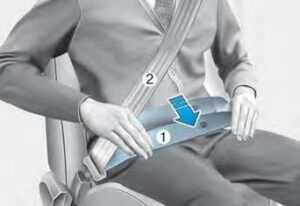 You should place the lap belt (1) portion across your hips and the shoulder belt (2) portion across your chest.
You should place the lap belt (1) portion across your hips and the shoulder belt (2) portion across your chest.
The seat belt automatically adjusts to the proper length after the lap belt portion is adjusted manually so that it fits snugly around your hips. If you lean forward in a slow, easy motion, the belt will extend and move with you.
If there is a sudden stop or impact, the belt will lock into position. It will also lock if you try to lean forward too quickly.
NOTICE
If you are not able to smoothly pull enough of the seat belt out from the retractor, firmly pull the seat belt out and release it. After release, you will be able to pull the belt out smoothly.
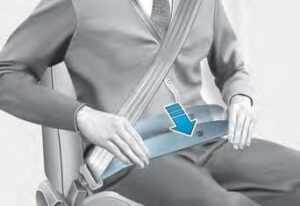 WARNING
WARNING
Improperly positioned seat belts may increase the risk of serious injury in an accident.
Take the following precautions when adjusting the seat belt:
- Position the lap portion of the seat belt as low as possible across your hips, not on your waist, so that it fits snugly. This allows your strong pelvic bones to absorb the force of the crash, reducing the chance of internal injuries.
- Position one arm under the shoulder belt and the other over the belt, as shown in the illustration.
- Always position the shoulder belt anchor into the locked position at the appropriate height.
- Never position the shoulder belt across your neck or face.
Height adjustment
You can adjust the height of the shoulder belt anchor to one of the four different positions for maximum comfort and safety.
The shoulder portion should be adjusted so it lies across your chest and midway over your shoulder nearest the door, not over your neck.
 To adjust the height of the seat belt anchor, lower or raise the height adjuster into an appropriate position.
To adjust the height of the seat belt anchor, lower or raise the height adjuster into an appropriate position.
To raise the height adjuster, pull it up
(1). To lower it, push it down (3) while pressing the height adjuster button (2).
Release the button to lock the anchor into position. Try sliding the height adjuster to make sure that it has locked into position. 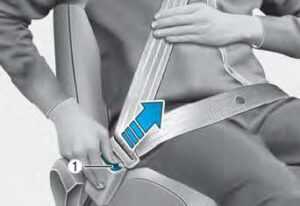 To release your seat belt:
To release your seat belt:
Press the release button (1) in the locking buckle.
When it is released, the belt should automatically draw back into the retractor. If this does not happen, check the belt to be sure it is not twisted, then try again.
Rear center seatbelt
(3-point rear center seat belt)  When using the rear center seat belt, the buckle with the “CENTER” mark must be used.
When using the rear center seat belt, the buckle with the “CENTER” mark must be used.
Information
If you are not able to pull out the safety belt from the retractor, firmly pull the belt out and release it. After release, you will be able to pull the belt out smoothly.
WARNING
Make sure that the seatback is locked in place when using the rear center seat belt.
If not, the seatback may move when there is a sudden stop or collision, which could result in serious injury.
Pre-tensioner seat belt 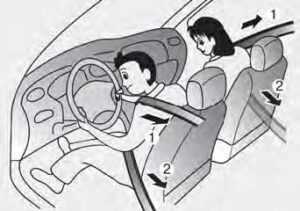 Your vehicle is equipped with driver’s and front passenger’s Pre-tensioner Seat Belts (Retractor Pretensioner and Emergency Fastening Device System). The purpose of the pre-tensioner is to make sure the seat belts fit tightly against the occupant’s body in certain frontal or side collision(s). The Emergency Fastening Device System may be activated in certain crashes where the frontal or side collision(s) is severe enough, together with the airbags.
Your vehicle is equipped with driver’s and front passenger’s Pre-tensioner Seat Belts (Retractor Pretensioner and Emergency Fastening Device System). The purpose of the pre-tensioner is to make sure the seat belts fit tightly against the occupant’s body in certain frontal or side collision(s). The Emergency Fastening Device System may be activated in certain crashes where the frontal or side collision(s) is severe enough, together with the airbags.
When the vehicle stops suddenly, or if the occupant tries to lean forward too quickly, the seat belt retractor will lock into position. In certain frontal or side collision(s), the pre-tensioner will activate and pull the seat belt into tighter contact against the occupant’s body.
- Retractor Pretensioner
The purpose of the retractor pre-tensioner is to make sure that the shoulder belts fit in tightly against the occupant’s upper body in certain frontal or side collision(s). - Emergency Fastening Device System The purpose of the Emergency Fastening Device System is to make sure that the pelvis belts fit in tightly against the occupant’s lower body in certain frontal or side collision(s).
If the system senses excessive tension on the driver or passenger’s seat belt when the pre-tensioner system activates, the load limiter inside the retractor pre-tensioner will release some of the pressure on the affected seat belt.
2023 Hyundai Sonata Specs, Price, Features, Milage (Brochure)
WARNING
- Always wear your seat belt and sit properly in your seat.
- Do not use the seat belt if it is loose or twisted. A loose or twisted seat belt will not protect you properly in an accident.
- Do not place anything near the buckle. This may adversely affect the buckle and cause it to function improperly.
- Always replace your pre-tensioners after activation or an accident.
- Never inspect, service, repair or replace the pre-tensioners yourself.
This must be done by an authorized HYUNDAI dealer. - Do not hit the seat belt assemblies.
 The Pre-Tensioner Seat Belt System consists mainly of the following components. Their locations are shown in the illustration above:
The Pre-Tensioner Seat Belt System consists mainly of the following components. Their locations are shown in the illustration above:
- SRS air bag warning light.
- Retractor pre-tensioner
- SRS control module
- Emergency fastening device
NOTICE
The sensor that activates the SRS control module is connected with the pre–tensioner seat belts. The SRS air bag warning light on the instrument cluster will illuminate for approximately 6 seconds after the START/STOP button is placed in the ON position, and then it should turn off.
If the pre-tensioner is not working properly, the warning light will illuminate even if the SRS air bag is not malfunctioning. If the warning light does not illuminate, stays illuminated or illuminates when the vehicle is being driven, have an authorized HYUNDAI dealer inspect the pre-tensioner seat belts and SRS air bags as soon as possible.
Information
- Pre-tensioner seat belts may be activated in certain frontal or side collisions or rollover situations (if equipped with rollover sensor).
- When the pre-tensioner seat belts are activated, a loud noise may be heard and fine dust, which may appear to be smoke, may be visible in the passenger compartment. These are normal operating conditions and are not hazardous.
- Although it is non-toxic, the fine dust may cause skin irritation and should not be inhaled for prolonged periods. Wash all exposed skin areas thoroughly after an accident in which the pretensioner seat belts were activated.
Additional Seat Belt Safety Precautions
Seat belt use during pregnancy
The seat belt should always be used during pregnancy. The best way to protect your unborn child is to protect yourself by always wearing the seat belt.
Pregnant women should always wear a lap-shoulder seat belt. Place the shoulder belt across your chest, routed between your breasts and away from your neck. Place the lap belt below your belly so that it fits SNUGLY across your hips and pelvic bone, under the rounded part of the belly.
WARNING
- Pregnant women and patients are more vulnerable to any impacts on the abdomen during an abrupt stop or accident. If you are in an accident while pregnant, consult your doctor.
- To reduce the risk of serious injury or death to an unborn child during an accident, pregnant women should NEVER place the lap portion of the seat belt above or over the area of the abdomen where the unborn child is located.
Seat belt use and children
Infants and small children
All 50 states have child restraint laws that require children to travel in approved child restraint devices, including booster seats. The age at which seat belts can be used instead of child restraints differs among states, so you should be aware of the specific requirements in your state, and where you are traveling. Infant and child restraints must be properly placed and installed in a rear seat. For more information refer to the “Child Restraint Systems” section in this chapter.
WARNING
ALWAYS properly restrain infants and small children in a child restraint appropriate for the child’s height and weight.
To reduce the risk of serious injury or death to a child and other passengers, NEVER hold a child in your lap or arms when the vehicle is moving. The violent forces created during an accident tear off the child and throw the child against the interior of the vehicle.
Small children are best protected from injury in an accident when properly restrained in the rear seat
by a child restraint system that meets the requirements of the Federal Motor Vehicle Safety Standards. Before buying any child restraint system, make sure that it has a label certifying that it meets Federal Motor Vehicle Safety Standard FMVSS 213. The restraint must be appropriate for your child’s height and weight. Check the label on the child restraint for this information. Refer to the “Child Restraint Systems” section in this chapter.
Larger children
Children under age 13 and who are too large for a booster seat should always occupy the rear seat and use the available lap/shoulder belts. A seat belt should lie across the upper thighs and be snug across the shoulder and chest to restrain the child safely. Check belt fit periodically. A child’s squirming could put the belt out of position. In the event of an accident, children are afforded the best safety restrained by a proper Child Restraint System in the rear seats.
If a larger child over age 13 must be seated in the front seat, the child must be securely restrained by the available lap/shoulder belt and the seat should be placed in the rearmost position.
If the shoulder belt portion slightly touches the child’s neck or face, try placing the child closer to the center of the vehicle. If the shoulder belt still touches their face or neck, they need to be returned to an appropriate booster seat in the rear seat.
WARNING
- Always make sure larger children’s seat belts are worn and properly adjusted.
- NEVER allow the shoulder belt to contact the child’s neck or face.
- Do not allow more than one child to use a single seat belt.
Seat belt use and injured people
A seat belt should be used when an injured person is being transported. Consult a physician for specific recommendations.
One person per belt
Two people (including children) should never attempt to use a single seat belt. This could increase the severity of injuries in case of an accident.
Do not lie down
Sitting in a reclined position when the vehicle is in motion can be dangerous. Even when buckled up, the protections of your restraint systems (seat belts and/or air bags) are greatly reduced by reclining your seatback.
Seat belts must be snug against your hips and chest to work properly.
During an accident, you could be thrown into the seat belt, causing neck or other injuries.
The more the seat back is reclined, the greater the chance for the passenger’s hips to slide under the lap belt or the passenger’s neck to strike the shoulder belt.
WARNING
- NEVER ride with a reclined seatback when the vehicle is moving.
- Riding with a reclined seatback increases your chance of serious or fatal injuries in the event of a collision or sudden stop.
- Driver and passengers should always sit well back in their seats with the seatbacks upright and should be belted properly.
Care of Seat Belts
Seat belt systems should never be disassembled or modified. In addition, care should be taken to assure that seat belts and belt hardware are not damaged by seat hinges, doors or other abuse.
Periodic inspection
All seat belts should be inspected periodically for wear or damage of any kind. Any damaged parts should be replaced as soon as possible.
Keep belts clean and dry
Seat belts should be kept clean and dry. If belts become dirty, they can be cleaned by using a mild soap solution and warm water. Bleach, dye, strong detergents or abrasives should not be used because they may damage and weaken the fabric.
When to replace seat belts
The entire seat belt assembly or assemblies should be replaced if the vehicle has been involved in an accident. This should be done even if no damage is visible. Additional questions concerning seat belt operation should be directed to an authorized HYUNDAI dealer.
FAQ
To adjust your seat for safety and comfort, ensure that you have a clear view of the road and can reach all controls easily. Sit with your back against the seatback and adjust the seat height, backrest angle, and distance from the steering wheel and pedals as needed.
Yes, when using child safety seats, it’s essential to follow the manufacturer’s instructions for installation and secure the child properly according to their age, weight, and height. Always use the appropriate child safety seat for your child’s size.
To ensure proper installation of a child safety seat, carefully follow the installation instructions provided by the child seat manufacturer. Additionally, consult your vehicle’s owner’s manual for information on child seat anchorage points (LATCH system) and safety belt use.
LATCH stands for Lower Anchors and Tethers for Children. It’s a system in vehicles that provides anchor points and connectors to secure child safety seats without using the vehicle’s seat belts. Consult your owner’s manual for the location of LATCH anchors in your Hyundai Kona-EV.
Seat belts should be inspected regularly for signs of wear, damage, or malfunction. If you notice any issues, have them inspected and replaced by a qualified technician as needed.
It’s essential for all passengers in the vehicle, including those in the rear seats, to wear their seat belts at all times when the vehicle is in motion. Ensure that seat belts are properly fastened and adjusted for each passenger.
When transporting a pet, use a secure pet restraint or crate to ensure their safety and prevent distractions while driving. Never allow pets to roam freely in the vehicle.
When driving in adverse weather conditions, such as rain, snow, or fog, reduce your speed, increase following distance, use headlights, and avoid sudden maneuvers. Ensure that your windshield wipers and defoggers are working correctly for visibility.
To defog the windows, use the vehicle’s defogger or defroster functions. Turn on the fan, adjust the temperature to a comfortable level, and direct airflow to the windshield. This will help clear condensation and improve visibility.
If your seat belts are locked after an accident, it’s an indication that the seat belt retractor mechanism has engaged to help secure you in place. The seat belts may need to be replaced, and it’s advisable to have the vehicle inspected by a qualified technician to ensure safety systems are functioning correctly.
Seat belts can be uncomfortable for some passengers. To improve comfort, use seat belt cushions or adjust the height of the shoulder strap anchor point if your vehicle allows it. Ensure that the seat belt is positioned correctly and not twisted.
Pregnant passengers should wear seat belts for their safety. To accommodate a growing belly, position the lap belt low and snug across the hips and below the belly. The shoulder belt should cross the chest and go between the breasts.
Airbags are a crucial part of a vehicle’s safety system, as they are designed to inflate rapidly in the event of a collision, providing an additional cushioning barrier between passengers and hard surfaces in the vehicle.
In some vehicles, there may be an option to deactivate the passenger-side airbag when using a rear-facing child safety seat. Follow the vehicle and car seat manufacturer’s instructions to determine if this is necessary and how to do it safely.
To ensure the proper functioning of safety systems in your Hyundai Kona-EV, follow the manufacturer’s recommended maintenance schedule and have the vehicle regularly inspected by a qualified technician. Additionally, be attentive to any warning lights or messages on the dashboard that indicate potential issues with these systems and address them promptly.
Useful Link
View Full User Guide: Hyundai Kona-EV 2023 User Guide
Download Manuals: https://owners.hyundaiusa.com/us/en/resources/manuals-warranties.html
2023 Hyundai Sonata Specs, Price, Features, Milage (Brochure)

